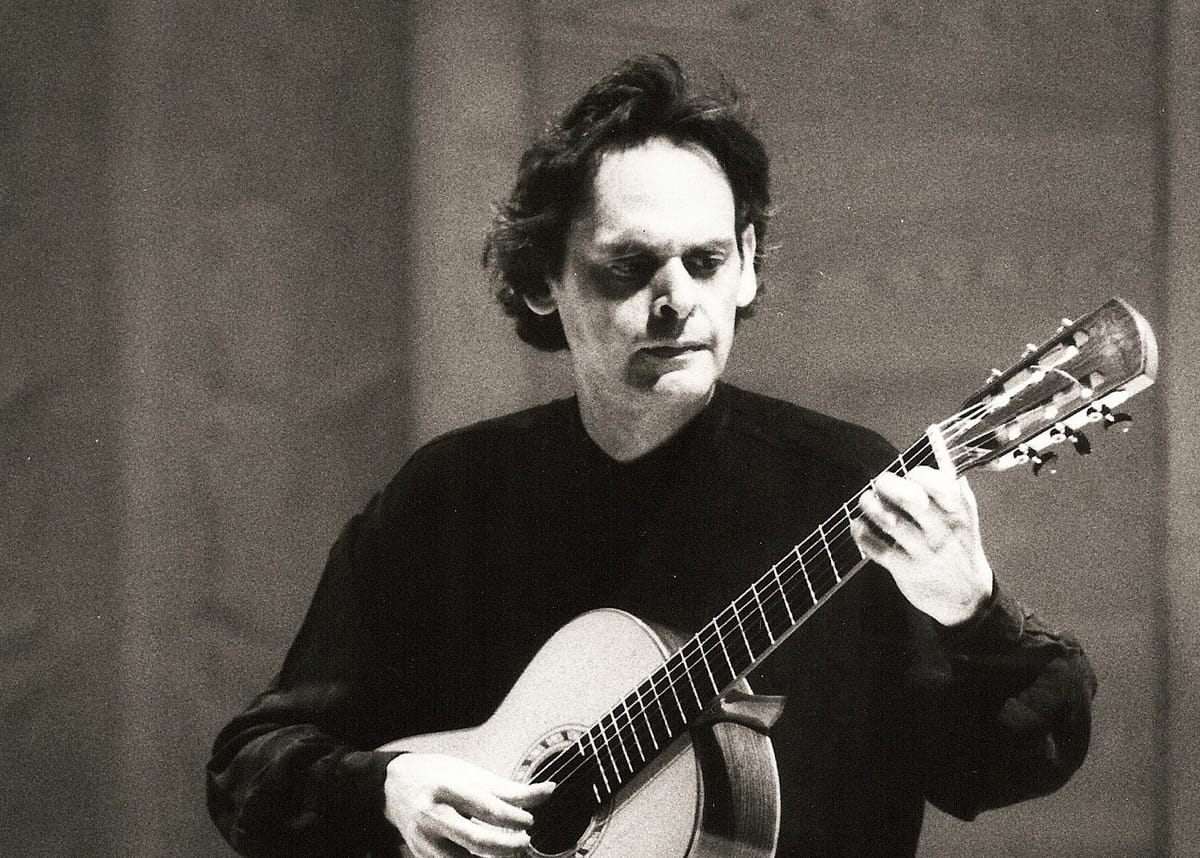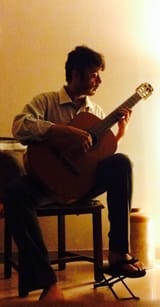Maestro Roland Dyens – Through his ‘Lettres’

A few years back, one of my friends gave me a copy of Maestro Roland Dyens’s Lettres (Letters, published 2001). I had heard a few of his works before. To name a few, Tango en Skaï, Libra Sonatine and Hommage à Frank Zappa. Although I had tried my hand at Tango en Skaï, these works always felt beyond my technical and musical capabilities at the time and so I made up my mind to try these out at a later date. When I got the Lettres from Veda, I read through its introduction and realised that Dyens had written these pieces keeping musicians like me in mind and I quote him from the Introduction:
“…I think what gives me most pleasure is the thought that at last my music will be accessible to a large number of guitarists who, for obvious technical reasons, felt until now somewhat excluded from the majority of my work. I hope, therefore, that this gap will be consigned to past history.”
More importantly, he goes on to say that combining good quality music with relative ease of playing was for him the most difficult thing to do in composition and this was his attempt at taking up this challenge, so to say.
‘Lettres’ is a set of 20 letters. Each of these addresses one or more technical challenges never foreshadowing the musical intention and compositional integrity. Each letter stands on its own as a piece of music. There are many aspects to these so-called ‘technical’ challenges, which caught my attention. The more I read through the elaborate notes written by Dyens in the Foreword, the more I understood that Dyens is trying to do away with many notions in guitar pedagogy and learning which had now been solidly entrenched. Dyens elaborates on the three primary axes to which he thinks musicians and particularly guitarists have not paid much attention to. These three axes are, to put it shortly – Tuning, Eliminating unwanted notes and Unnecessary ‘squeaks’.
When you go through the set of letters, you realise the depth and breadth of Dyens’s thought as a composer, teacher and performer. Although these letters are posited as a set of miniature studies, the musical and pedagogical thought that has gone behind the writing is far more fundamental to overall musicality, musicianship and performance in general.
TUNING
Tuning has never been a big subject in the guitar community till recent past. Although it still might seem like an obvious and overrated subject for most guitar players, it is a deep subject which requires extra attention and awareness. The changes in guitar construction in the last century coupled with the kind of music written for it especially after 1950, has intensified the concerns about tuning. Dyens has been very concerned with the guitar being always ‘almost’ in tune. This has a direct connection with what the player is capable of ‘hearing’. Unless the performer is acutely conscious of the overtones generated by the guitar (even after damping the unwanted strings), he/she will never be able to appreciate the minute tuning adjustments that need to be done. Moreover, this harks back at the fundamental notion of how the performer delves into the composer’s ‘intent’. Dyens notes that ‘western’ musicians need to look at tuning as a pleasurable ritual, much in the way Indian classical musicians or Flamenco players have done. To that effect he writes, it should become part of the performance, rather like a prelude to a piece of music. Being right in the centre of an active Indian classical music milieu, this makes complete sense to me. On numerous occasions as a listener, I have drowned along with the performers in the deep joy and meditative involvement which goes into tuning the Taanpura (an accompanying instrument), the Sitar or the Veena/Been for instance. For musicians who are exposed to Indian classical music, it should come to us naturally then to be conscious and aware of fine-tuning our instruments. Although I was very conscious about this in the Indian music context, it was Dyens who first made me aware of fine-tuning a ‘tempered’ instrument such as the guitar. I also owe it to a dear friend and teacher, Jayant, who through his interesting expositions and discussions on ‘Modern’ music has stressed on the importance of tuning and how the idiosyncrasies of guitar tuning (and by that logic the overtones generated) are built into a lot of music written for the guitar especially post World War II.
ELIMINATING UNWANTED NOTES
From the foreword:
“…how many guitarists, whether beginners or experienced performers, commonly put into practice the techniques that will efficiently eliminate unwanted notes(…produced or implied by vibrations of open strings..)…it is an important part of putting the message across on the guitar, leading to greater clarity of parts in contrapuntal passages, and clearer harmony in the chords.”
Again, this is an area which according to Dyens needs to be looked at very seriously. The guitar has a propensity to set in motion the open strings which then in turn create their own overtones. The issue of damping and being extra conscious of the creation of overtones via open strings is a focal point in this set of pieces. Dyens is extremely meticulous in his writing, sometimes explicitly directing the performer to silence strings because of possible overtone creation, even if that particular string has not been played before. In many Indian instruments, all strings (including the main and sympathetic strings) are tuned to the notes (swara, वर) of the raga. They are ‘meant’ to be set in motion when the performer plays on the main strings. This creates a rich tapestry of overtones (naad, नाद). This musical outcome is required and necessary and is built into the aesthetics of the music and instrument making.
If we look at the guitar, it has no sympathetic strings. The main strings on which we play are tuned in fourths if we start from the lowest (in pitch) string to the highest (except the third and second, where the second is tuned a third from the third string). This system of tuning possibly has roots in the guitar’s complex history as a folk instrument spread across a wide geography and being at a meeting point of ‘western’, ‘middle-eastern’ and ‘eastern’ influences. As mentioned earlier, when a string is played, it creates its own overtones. Additionally, it sets into motion the open strings, which in turn create their own overtones. Now consider the fact that on the guitar, the frets are placed according to the tempered scale. Now the note is played by pressing the string on a fret (tempered note) and it creates its own overtones. If the open strings are not dampened, they vibrate creating ‘natural’ overtones (since the open strings are not played by pressing the string on a tempered fret). So, here we should consider ‘tempered’ notes with their overtones on one hand and open strings creating their own overtones on the other hand. In effect, do we create a mesh of tempered and non-tempered notes and overtones, if we do not silence the unwanted open strings? This is amongst the many questions which have come up in recent discussions with friends and colleagues regarding guitar tuning and guitar construction.
UNNECESSARY ‘SQUEAKS’
The lower strings are steel wound nylon strings and when we move our hand to higher frets from lower frets on the same string, there is a possibility that there is a squeak. This happens especially when there is a glissando in the music. There are some other kinds of sounds generated during pull-offs or hammer-ons which are strictly not a part of the music per se. Should these be completely done away with? Here is where I am not completely on the same page as Dyens. For him, it is an unwanted sound. In my own thoughts, it is something to do with the nature of the instrument. Also having played steel string guitar before in folk-blues contexts, the little squeaks were in fact adding more texture. Nevertheless, I do think while playing classical music, this need not be the case and Dyens makes an important point in making us conscious of these unwanted sounds.
Besides the fact that I have liked his music, Dyens is an inspiration in another respect. He has revived the age old tradition of the performer-improviser, which had been lost for the last 150 years in mainstream Western classical music. My friend and teacher, Jayant Sankrityayana (a jazz and classical musician) says that most of Dyen’s music sounds improvised. I take this to mean that he has kept a lot of that spontaneity in improvisation alive in his music, choosing not to smoothen out those aspects when writing or revising a written work.
Thanks for all the letters, essays, thoughts, performances and most of all, your music, Maestro Dyens.
This article was first published on The Pune Guitar Society





